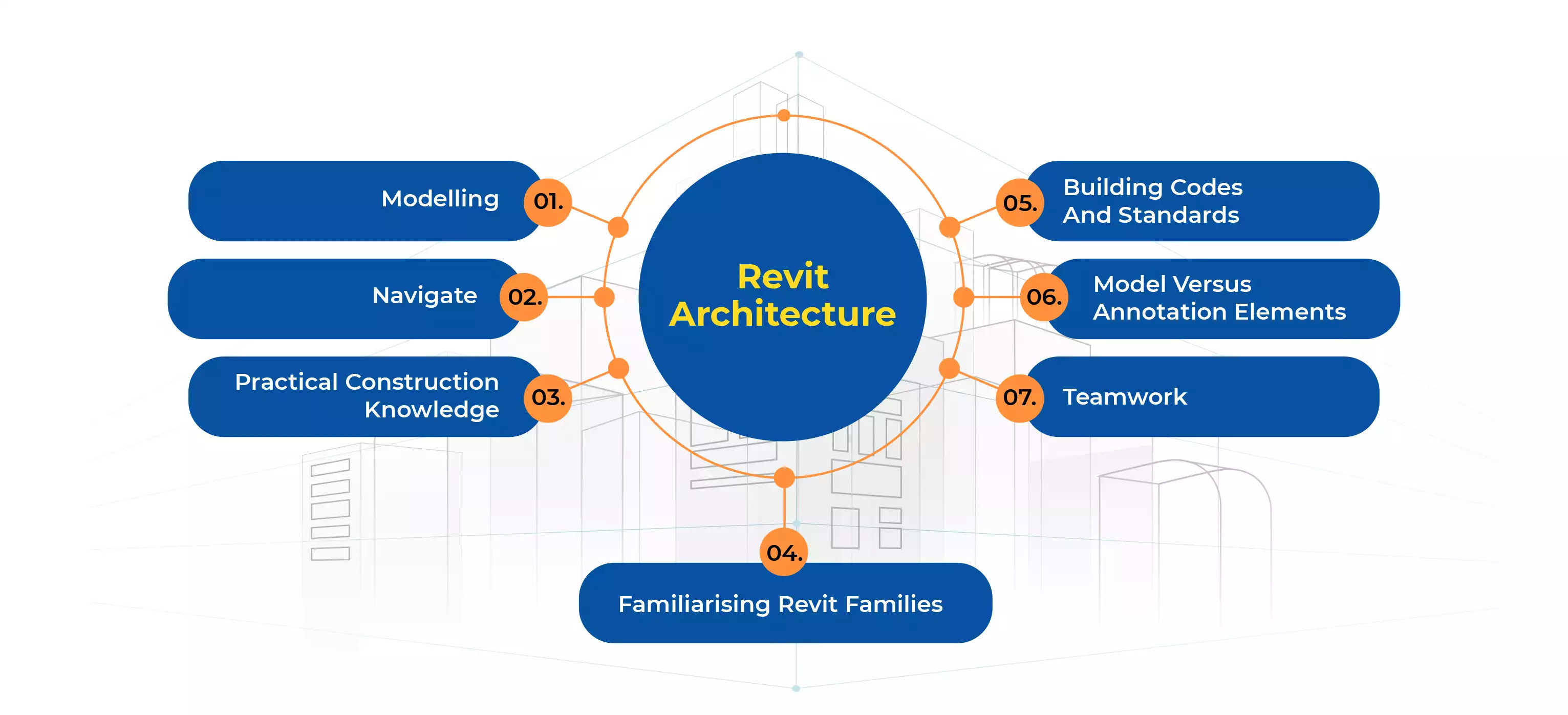 Shaheen M
Jan 07, 2025
Shaheen M
Jan 07, 2025

Nowadays, it is nearly impossible to imagine any project in the construction industry being executed without the help of BIM software. Revit has been the leader in the field, and the tool keeps receiving updates that improve its functionality. In addition, the platform offers a variety of options that are not available with other similar devices.
Also Check Out: Why Should You Learn BIM?
Mastering Revit architecture requires a set of critical skills. But, if you have them, you can confidently showcase them in your resume and gain an edge over others. Consider what skills you will need to master Revit architecture. Here are the Key Revit Architecture Skills;
Revit modeling teaches you how the modifications you make to elements in one view are reflected in all subsequent views. A view in Revit displays the model from a certain angle, like a floor plan or duct elevation. The building design is represented virtually in 3D by the Revit model. It captures the design intent, the geometry of model elements, and the logical connections between those pieces.
You can use Revit's navigating skills to learn how to access views and move around the model. The floor plan, elevation, section, or detail view may be displayed in the 2D views, which are slices of the model. The drawing area's navigation bar and the ViewCube in 3D views provide a different navigation techniques.
The industry standard for initial construction design drawing has historically been AutoCAD. Since drawings are your primary means of communicating your designs, drafting experience is required. The two most potent CAD programs are AutoCAD and Microstation.
Also Read :Career Opportunities After Revit Certification
Architectural designers should have practical construction knowledge to connect the designs to the activity on the construction site. Engineers in the office only design the plans; construction workers carry them out. Engineers frequently create designs that make little sense because they need to gain industry knowledge in the construction industry. Architects and designers dominated the accident's cover-up because their jobs occasionally required them to visit construction sites.
Architectural designers should have practical construction knowledge to connect the designs to the activity on the construction site. Engineers in the office only design the plans; construction workers carry them out. Engineers frequently create designs that make little sense because they need to gain industry knowledge in the construction industry. Architects and designers dominated the accident's cover-up because their jobs occasionally required them to visit construction sites.
Also Read: Advantages of Learning Revit Structure
Knowledge of local codes and standards improves your design abilities; instead of memorising the codes, recognising that specific rules apply to hasten the job process. Regardless of your level of experience, staying up to date with the latest trends is imperative.
This essential skill in Revit architecture helps you learn how to place model and annotation elements in the views of the models. The model elements represent the physical structure of the design, like walls, windows, and doors, visible in all pictures. Annotation and detail elements add dimensions, notes, and tags to the views. It adds details to the graphically generated model geometry. They are specific and appear only in the opinions you have placed them.
Most occupations demand the ability to work in a team. Teamwork abilities are essential for Revit architectural professionals because the architecture industry is multidisciplinary. In a single building project, there will be frequent back-and-forth contact between the teams of architects, civil engineers, mechanical engineers, electrical engineers, etc. Having extraordinary cooperation abilities to coordinate designs with other professions is advantageous.
Also Read: Skills Needed to Master Revit MEP
Revit is one of the most popular choices among professionals since it is specifically designed for Building Information Modeling (BIM). This software will allow architects to create a building’s digital model that captures all the essential components, from the dimensions of the rooms to the location of the windows and doors. To get the most out of this software, however, it is crucial to master the Revit architecture skills. With Revit, architects can bring their ideas to life with greater accuracy and efficiency, making it an essential tool for anyone pursuing a career in architecture. So if you wish to have a career in Revit architecture, be sure to get certified.
You May Also be Interested in: Benefits Of Revit Structure Certification
Explore the Revit Training Courses Offered By Edoxi Training Institute in various countries and locations in the Middle East.
| Country | UAE | Oman | Qatar |
| Course Location | Dubai | Muscat | Doha |

Shaheen is an expert Corporate Trainer in BIM, Architecture and CAD with over 8+ years of experience. His expertise includes advanced 3D BIM Modeling, Architectural Drafting and Detailing, and Interior & Visualization Design. Additionally, he offers tailored training programs specific to various industry needs. He has trained over 5,000 professionals in advanced modeling and design techniques.
Shaheen’s training expertise spans HVAC Design, Electrical Design, Tekla, Lumion, STAAD.Pro, AutoCAD 2D & 3D and Civil 3D. Through his hands-on teaching approach, Shaheen ensures that students engage with real-world architectural projects. His corporate training portfolio includes some of the top architectural companies in Dubai. He has trained professionals from universities, including Sharjah University, Ajman University and Canadian University, and companies such as KhanSaheb, HCTS, Silver Pool Technologies and many more. His practical industry experience enriches the training program's real-world value.